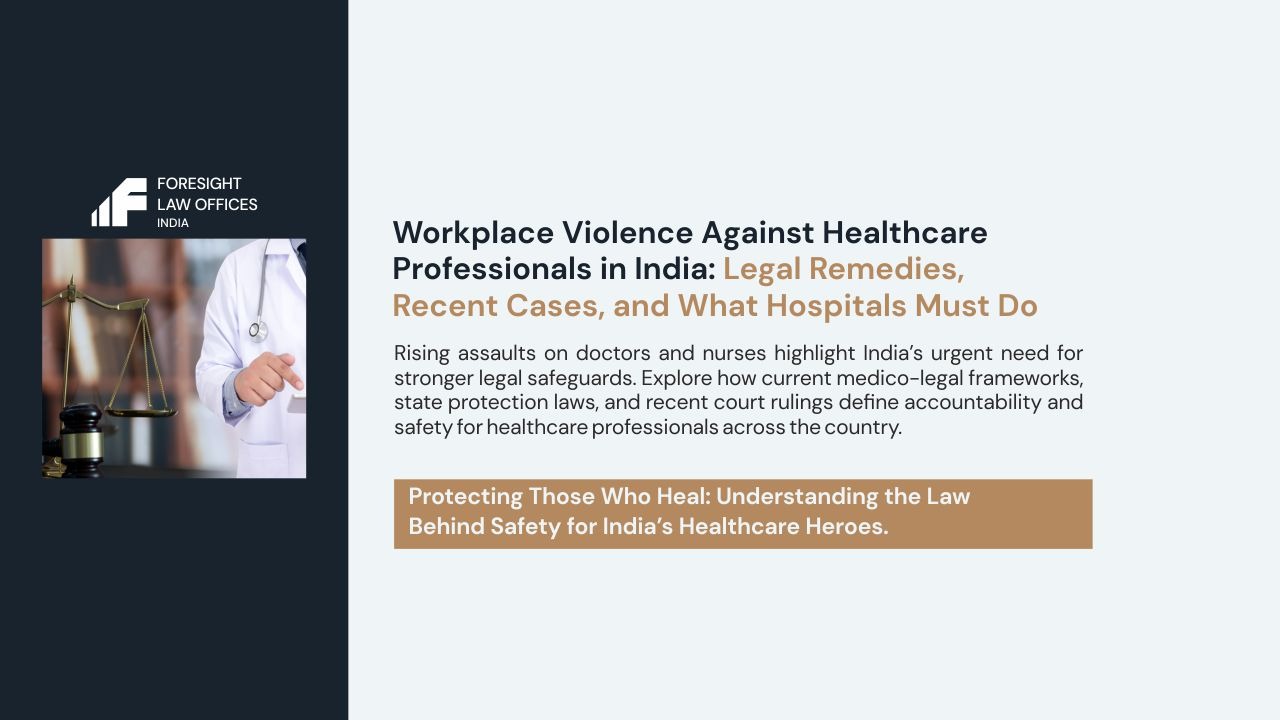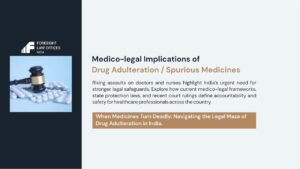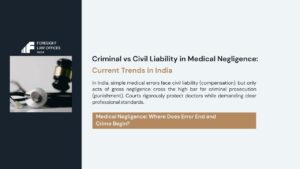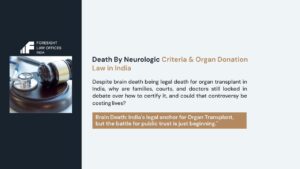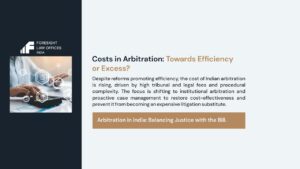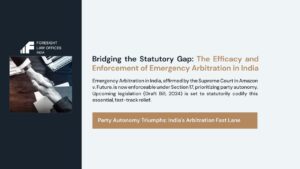Workplace violence against doctors, nurses, and other healthcare staff has become one of India’s most urgent medico-legal problems. Beyond the human tragedy, every attack triggers questions that legal teams and administrators must answer fast: Which law applies: state or central? What charges fit under the Bharatiya Nyaya Sanhita (BNS)? Can the hospital claim compensation for property damage? What immediate court remedies are available?
This article maps the current law, highlights recent cases, and offers a compliance playbook for hospitals and a quick reference for any medical lawyer handling such matters.
Central vs State: What Laws Actually Protects Doctors?
- General criminal law (BNS, 2023)
Even where there is no special “doctor-protection” statute in play, the BNS (successor to IPC) criminalizes assault, criminal force, hurt and grievous hurt, mischief, criminal intimidation, rioting, trespass, etc. Charges typically invoked in hospital-violence FIRs include voluntarily causing hurt or grievous hurt, criminal intimidation, and mischief causing damage. Comparative tables mapping IPC to BNS help police and courts anchor the correct sections.
- Special protection during epidemics (now on the statute book)
The Epidemic Diseases (Amendment) Act, 2020 inserted stringent protections for “healthcare service personnel” during an epidemic, making violence cognizable and non-bailable, with enhanced penalties and time-bound investigation. This is not a permanent, all-time healthcare violence law; it applies in the context of a notified epidemic. Still, the text remains a powerful precedent for deterrent penalties.
- State-level Medical Protection Acts (MPAs)
Because “public health” is largely a State subject, many States enacted Medical/Medicare Protection Acts that specifically criminalize violence against “medicare service persons” and damage to “medicare service institutions,” often declaring offences cognizable and enabling recovery of loss for damaged property. Examples include Maharashtra (2010) and Andhra Pradesh/Telangana (2008), among others. A 2025 comparative analysis and policy notes indicate 19+ states (often over 20) have such laws.
- No uniform central “doctor-protection” law-policy debate continues
The Union government (2024) told Parliament and the press there is no plan for a separate central law, reasoning that states already have statutes and the BNS covers core offences. Professional bodies, editorial boards and a Supreme Court-led task force conversation continue to press for a uniform law; the 2019 draft central bill never became law, and a 2022 private member bill remains at the “as introduced” stage.
Practical takeaway for a medical lawyer: In most incidents outside an epidemic, your primary tools are (i) the applicable State MPA, (ii) BNS offences, and (iii) general criminal procedure. During an epidemic, add the Epidemic Diseases (Amendment) Act, 2020 enhancements.
Recent Incident That Are Spine-Chilling
The R.G. Kar Medical College rape-and-murder (Kolkata, 9 Aug 2024)
The rape and murder of a postgraduate doctor at R.G. Kar Medical College sparked national protests, shutdowns of OPDs, and litigation. The Calcutta High Court transferred investigation to the CBI; the matter reached the Supreme Court, which monitored status reports and balanced protest rights with continuity of essential services. The case catalyzed hospital security reviews nationwide.
Security directives and institutional responses in 2025
Courts have continued to intervene for campus security where needed, for example, Calcutta High Court directions to ensure police protection and regulate access at a medical college amid unrest; elsewhere, public hospitals tightened access controls and escort protocols for female doctors after the Kolkata events. These orders and administrative steps illustrate how writ remedies and local governance fill gaps while policy debates continue.
Supreme Court & national policy conversation
Following petitions after the Kolkata incident, the Supreme Court pressed the Union to ensure immediate safety measures, while a national task-force reviewed whether a central statute is necessary, amid government statements that state laws, BNS suffice. Editorials in major medical journals continue to call for a purpose-built national law.
What Remedies Can a Hospital or Injured Clinician Seek (Step by Step)
- Immediate criminal law action
File an FIR citing the relevant State Medical Practitioner Association (if applicable) and BNS offences (hurt/grievous hurt, criminal intimidation, mischief, trespass, rioting, etc.). Many MPAs make offences cognizable; the BNS is your base grid for assault-type offences.
During a notified epidemic, additionally invoke the Epidemic Diseases (Amendment) Act, 2020 (non-bailable, enhanced penalties, time-bound investigation).
- Writ petition for protection & crowd control
Hospitals or resident doctor bodies can move the High Court under Article 226 for directions to police: perimeter security, cordoning sensitive zones (ICU/OT/hostels), regulating access, and ensuring safe movement of staff. The recent Kolkata and Durgapur matters show High Courts issuing targeted security orders.
- Compensation & recovery for property damage
Many MPAs expressly enable recovery of loss from perpetrators for damage to hospital property (ambulances, equipment, wards). Document the damage with CCTV footage, photographs, audited estimates, and inventory logs to support recovery proceedings. (See state MPA texts such as Maharashtra 2010; AP/Telangana 2008).
- Service-continuity orders
Where protests paralyze services, courts may direct a minimum services plan, keeping emergency/critical care running while ensuring staff safety. The Supreme Court’s stance during the R.G. Kar fallout underscored patient rights alongside the demand for justice.
- Parallel administrative action
Hospitals should notify the State health department and, where applicable, the Clinical Establishments Act authority; maintain incident registers, security SOPs, and staff debriefs, which later support criminal prosecution and insurance claims. (Health being a State subject, compliance matrices differ across States.)
4) How State MPAs Differ (and Why It Matters)
State Acts share a core: they prohibit violence against defined “medicare service persons” (doctors, nurses, paramedics, students) and damage to property of a “medicare service institution” (public and usually private facilities). Differences arise in:
- Definitions (who is covered; inclusion of students/ambulance staff/medical camps),
- Penalties and bailability,
- Cognizability, and
- Recovery and summary attachment mechanisms for property damage.
For instance, Maharashtra’s 2010 Act and Andhra Pradesh/Telangana’s 2008 Act expressly provide for recovery of damage and robust policing powers. A 2025 comparative review shows several States expanding coverage (e.g., including medical camps), and punishing attempt/abetment/incitement alongside the core offence.
Advice from a medical law perspective: When advising a hospital group across multiple States, build state-wise response sheets mapping (i) covered personnel/institutions, (ii) penalties/bailability, (iii) special police powers, (iv) recovery processes, and (v) any rules on compounding.
Case Snapshots & Lessons for Compliance
- Kolkata (R.G. Kar, Aug 2024): A heinous murder of a doctor on duty led to CBI probe and Supreme Court monitoring; nationwide protests forced hospitals to reassess hostel security, visitor control, and CCTV coverage. Lesson: courts will push for both justice and continuity of essential services—prepare security-plus-service plans.
- High Court security orders (2025): The Calcutta High Court directed police to fortify a medical college campus amid ongoing unrest around exam dates—showing writ courts’ readiness to tailor campus-security solutions quickly. Lesson: don’t hesitate to seek targeted writ relief with affidavits, CCTV extracts, and incident logs.
- Hospital-level tightening (2025): Post-Kolkata, institutions like government medical colleges in Nagpur restricted hostel access and added escorts for women doctors. Lesson: courts notice good-faith institutional measures, document them; they also reduce liability exposure in subsequent negligence or safety suits.
The Hospital Playbook: Security & Legal Readiness (What a Medico-Legal Team Should Implement)
- Zero-gap access control: Gate logs, visitor IDs, geo-fenced access, and escorts for vulnerable shifts/areas (ER, OBG-OT, hostels). Post clear “protected premises” notices referencing the State Medical Practitioner Association.
- CCTV with retention & audit: High-resolution coverage of ER, ICU approaches, pharmacy cash points, and hostel corridors; 90-day retention (or more) where feasible; tamper alarms.
- Incident command & evidence kit: On any incident, activate a code security protocol, preserve CCTV, seize objects used in violence with police panchnama, collect MLCs of injured staff, and photograph damage with timestamps for recovery claims under the State Medical Practitioner Association.
- Police & court liaison: A designated nodal officer who knows local SHO/DCP; pre-drafted FIR templates tagging the State Medical Practitioner Association + BNS sections; a writ petition boilerplate for urgent High Court relief (campus protection, perimeter orders).
- Staff training & de-escalation: Regular drills for triage-crowd control; scripts for breaking bad news; panic buttons in ER and billing; a “three-ring” response (security, clinician, administrator).
- Communication plan: Public notices condemning violence, assuring patient care continuity, and explaining legal consequences under the State MPA—deterrence by transparency.
- Insurance & indemnity: Review property and liability policies for riot/vandalism coverage; ensure panel counsel (medical lawyer) is on call to move urgent motions.
- Hostel/quarters safety: Controlled entry, lighting, women-only escorts after hours, and grievance hotlines; these steps have been explicitly cited in post-Kolkata institutional orders.
Policy Cross-winds: Will There Be a Central Law?
- Govt stance (2024–25): No separate central law is planned; States already legislate and the BNS covers core crimes. A national task force also felt state frameworks exist across 24 States.
- Medical community view: Journals and the IMA continue to argue that fragmented State laws yield patchy enforcement and call for a uniform central statute with strong minimum standards. BMJ
Forecast for a medical law practice: Even if a central law remains elusive, expect model rules, SOP advisories, and court-led compliance directions to tighten. Hospitals with demonstrable security programs will be treated more favorably in writs and tort suits.
Quick Reference for the Front-Line Medical Lawyer
- FIR ingredients: State MPA sections + BNS (hurt/grievous hurt, intimidation, mischief, criminal trespass/rioting). Attach damage inventory for recovery.
- During epidemics: Add the Epidemic Diseases (Amendment) Act, 2020 (non-bailable, enhanced punishment, time-bound investigation).
- Writ prayer set: Police deployment, perimeter control, safe corridors, no-assembly zones in ER/OT, protection for exam days/hostels; compliance report from police.
- Civil/administrative follow-up: Recovery of property damage under MPA; insurance notification within policy timelines.
- Evidence discipline: CCTV backups, medical records (MLCs of injured staff), staff statements, and a consolidated incident file, courts take these seriously.
Conclusion
India’s protection for healthcare staff is a layered regime: State Medical Protection Acts as the frontline, BNS for core crimes, and Epidemic Diseases (Amendment) Act, 2020 for epidemic-time attacks. The Kolkata R.G. Kar tragedy and 2025 High Court interventions show courts will act swiftly to protect campuses and nudge the executive to do more. Until any uniform central law materializes, the best defense is preparation: rock-solid security SOPs, state-wise legal playbooks, and rapid recourse to courts. For hospitals and any medico-legal or medical lawyer, this is not just a litigation issue; it is medical law risk management, minute by minute.

